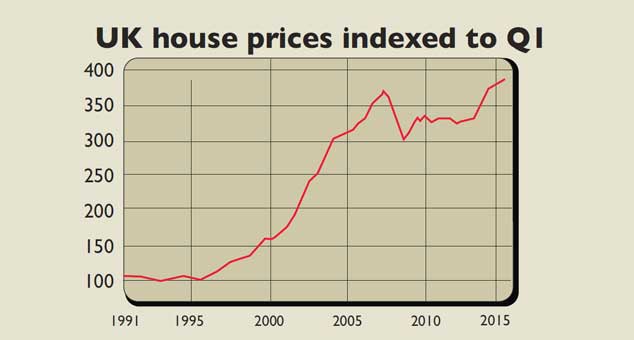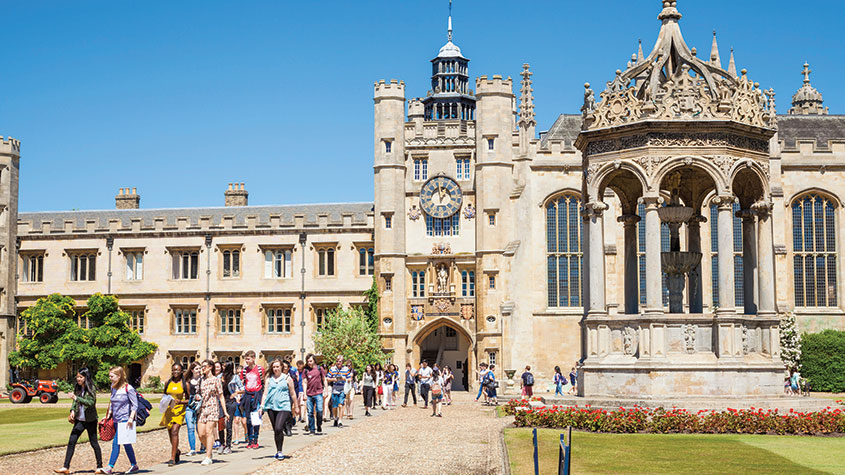Where to look for property bargains
New tax rules will make residential property in the UK less attractive to buy-to-let investors. But certain areas of the country have more potential than others, says John Stepek.

George Osborne's new tax rules will almost certainly make residential property in the UK less attractive to investors. But do certain areas have more potential than others? The UK housing market is often referred to as a bubble market, and affordability is certainly not improving, with average wages lagging house-price growth. However, if you take a step back from the UK-wide averages, then there's a very clear divide between north and south or more explicitly, between London and everywhere else.
If you look at Nationwide's price data, for example, then even in nominal terms (ie, ignoring inflation, which would make the figures look even worse), house prices in many areas are still lower than they were at the peak of the last bubble. In Northern Ireland, average house prices are still more than 40% down on the peak. The region has been battered by the fallout from Ireland's bubble, so it arguably should be excluded for these purposes. But prices in Scotland, Wales and the north of England are 5%-8% lower than in mid-2007 (a prettygrim return over eight years). In the Midlands, prices are flat. In the South West, prices are up about 5%, whilein East Anglia they are 7% higher.

Of course, certain towns and cities will have done better or worse than others it's hard to generalise across whole nations, as for Scotland and Wales. But for "mania" conditions, there's no question that London and its commuter belt in the South East are the only regions where we're genuinely back to post-crash bubble territory. London prices are roughly 40% higher than at the 2007 peak, with a 20% rise in the "outer metropolitan" area (the bits that are within commuting distance of London) and a 13% rise in the rest of the South East.
Subscribe to MoneyWeek
Subscribe to MoneyWeek today and get your first six magazine issues absolutely FREE

Sign up to Money Morning
Don't miss the latest investment and personal finances news, market analysis, plus money-saving tips with our free twice-daily newsletter
Don't miss the latest investment and personal finances news, market analysis, plus money-saving tips with our free twice-daily newsletter
And according to an analysis of Land Registry data by The Guardian, London is by far the least-affordable area, with the average property price now 12 times the regional average income compared to 4.4 times in 1995 (which was also high by UK standards at the time). We're not suggesting you pile into buy-to-let now that the government has landlords in its sights, the latest tax raid is unlikely to be the last. But if you do, the figures suggest you should look beyond London.
Now's not the time to start up as a landlord
Make of all that what you will. The truth is that if you want to invest sensibly in buy-to-let property, what matters as with any sensible investment is the income that it'll produce for you over time. You can't bet on capital growth materialising (as many investors, happy with miniscule yields in the likes of London, seem to be doing right now), particularly given that as James notes above it's hard to see interest rates going lower from current levels, even if it takes a while for them to rise again. And therefore, the key point about the chancellor's changes to the buy-to-let tax regime is that they will make it harder to get a decent yield on buy-to-let, across the board. That has to make it less attractive as an asset class overall.
If you're still dead keen, remember that again, as with any other asset class your yield should reflect your risk. LendInvest's buy-to-let index might indicate double-digit yields in less salubrious areas of Glasgow, but that's because they're riskier bets than a waterfront flat in central London. And if, on the other hand, you can only muster up a single-digit yield, are you really better with a single buy-to-let property than a portfolio of blue-chip dividend-paying stocks? In all, given the alternatives, it's hard to make the case for buy-to-let right now now is not the time to start a career as an amateur landlord.
See also:
The death knell for buy-to-let?
Get the latest financial news, insights and expert analysis from our award-winning MoneyWeek team, to help you understand what really matters when it comes to your finances.
John Stepek is a senior reporter at Bloomberg News and a former editor of MoneyWeek magazine. He graduated from Strathclyde University with a degree in psychology in 1996 and has always been fascinated by the gap between the way the market works in theory and the way it works in practice, and by how our deep-rooted instincts work against our best interests as investors.
He started out in journalism by writing articles about the specific business challenges facing family firms. In 2003, he took a job on the finance desk of Teletext, where he spent two years covering the markets and breaking financial news.
His work has been published in Families in Business, Shares magazine, Spear's Magazine, The Sunday Times, and The Spectator among others. He has also appeared as an expert commentator on BBC Radio 4's Today programme, BBC Radio Scotland, Newsnight, Daily Politics and Bloomberg. His first book, on contrarian investing, The Sceptical Investor, was released in March 2019. You can follow John on Twitter at @john_stepek.
-
 Average earnings by region – how does your income compare?
Average earnings by region – how does your income compare?There are significant regional differences when it comes to how much the average worker earns. We explore the data and reveal where in the UK average earnings are highest.
-
 St James’s Place confirms new fees – what it means for customers
St James’s Place confirms new fees – what it means for customersThe UK’s largest wealth manager is replacing its “opaque” and “complex” pricing structure. We explain the new charges, and when they will kick in
-
 Invest in space: the final frontier for investors
Invest in space: the final frontier for investorsCover Story Matthew Partridge takes a look at how to invest in space, and explores the top stocks to buy to build exposure to this rapidly expanding sector.
-
 5 of the world’s best stocks
5 of the world’s best stocksCover Story Here are five of the world’s best stocks according to Rupert Hargreaves. He believes all of these businesses have unique advantages that will help them grow.
-
 The best British tech stocks from a thriving sector
The best British tech stocks from a thriving sectorCover Story Move over, Silicon Valley. Over the past two decades the UK has become one of the main global hubs for tech start-ups. Matthew Partridge explains why, and highlights the most promising investments.
-
 How to invest in videogames – a Great British success story
How to invest in videogames – a Great British success storyCover Story The pandemic gave the videogame sector a big boost, and that strong growth will endure. Bruce Packard provides an overview of the global outlook and assesses the four key UK-listed gaming firms.
-
 How to invest in smart factories as the “fourth industrial revolution” arrives
How to invest in smart factories as the “fourth industrial revolution” arrivesCover Story Exciting new technologies and trends are coming together to change the face of manufacturing. Matthew Partridge looks at the companies that will drive the fourth industrial revolution.
-
 Why now is a good time to buy diamond miners
Why now is a good time to buy diamond minersCover Story Demand for the gems is set to outstrip supply, making it a good time to buy miners, says David J. Stevenson.
-
 How to invest in carbon capture and storage in the quest for net zero emissions
How to invest in carbon capture and storage in the quest for net zero emissionsCover Story Switching to green energy is unlikely to be enough to get the world to “net zero”. Carbon capture and storage (CCS) technologies will also play a key role. Matthew Partridge explores the sector and picks the best ways to invest.
-
 Why the UK's investment prospects are improving
Why the UK's investment prospects are improvingCover Story The outlook for the UK has darkened since last year, but the chancellor’s £15bn energy relief package should mean recession is avoided, says John Stepek.
